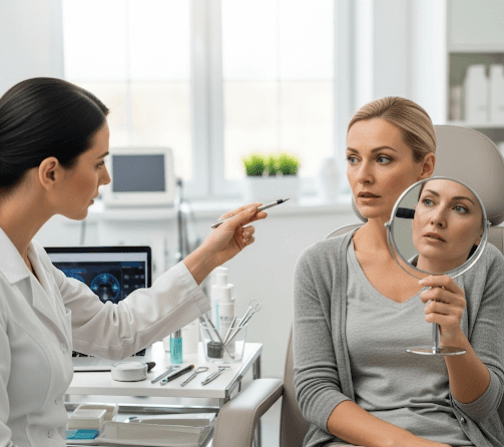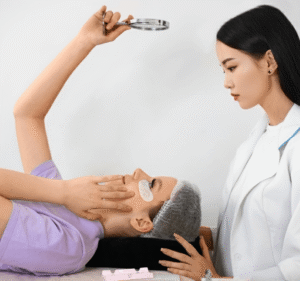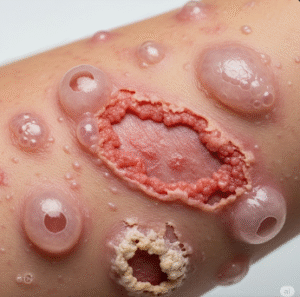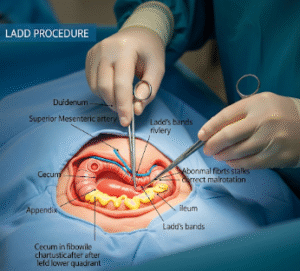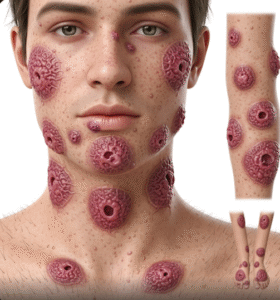What it is
→ A cosmetic dermatology consult is a professional evaluation with a dermatologist that focuses on improving the skin’s appearance, aesthetics, and overall health.
→ Unlike medical dermatology, which treats conditions like psoriasis, eczema, or skin cancer, cosmetic dermatology is centered on enhancement and rejuvenation.
→ During a consult, dermatologists assess skin type, texture, tone, age-related changes, and cosmetic concerns such as acne scars, pigmentation, wrinkles, fine lines, enlarged pores, and uneven complexion.
→ The goal is to create a personalized treatment plan using advanced technologies, skincare protocols, and procedures tailored to the patient’s needs and preferences.
Why it’s done
→ A cosmetic dermatology consult is recommended for individuals who:
- Want to improve appearance of skin for anti-aging, brightness, or clarity.
- Struggle with stubborn skin conditions (scars, pigmentation, uneven tone) that cosmetic products alone cannot address.
- Wish to explore minimally invasive options before considering surgical treatments.
- Desire personalized skincare advice instead of generic cosmetic routines.
- Seek to boost confidence and self-esteem through professional skin care.
→ It is also useful for preventive care, as dermatologists can detect early signs of sun damage, premature aging, or other concerns that, if treated early, may delay more aggressive interventions later.
Alternatives
→ While a professional consult is the gold standard, some alternatives include:
- Over-the-counter skincare → self-selected products for anti-aging, acne, or brightening.
- Beauty salon facials → aesthetic treatments performed by non-medical specialists.
- Online consultations → virtual assessments, though limited in precision without in-person skin analysis.
- Home remedies → natural masks or DIY skincare routines.
→ These alternatives may offer mild improvements, but they lack the diagnostic accuracy and advanced options provided by a dermatologist.
Preparation
→ Preparing for a cosmetic dermatology consult helps maximize results:
- Arrive with a clean face → avoid makeup, sunscreen, or tinted moisturizers so the skin can be examined clearly.
- List current products → bring details of all skincare products currently in use (cleansers, serums, creams, sunscreens).
- Medical history → share information about allergies, medications, or past cosmetic treatments.
- Note concerns → prepare a list of specific issues (wrinkles, pigmentation, acne, dullness, texture) to discuss.
- Set goals → clarify whether you seek short-term event-based results or long-term maintenance.
- Bring past records → if you had previous laser or filler treatments, bring documentation for review.
How it’s Done
→ A cosmetic dermatology consult usually follows a structured process:
- Skin analysis → dermatologists use magnifying tools, dermoscopy, or imaging technology to assess skin type, hydration levels, pore size, sun damage, and pigmentation.
- Discussion of concerns → patients explain their main cosmetic goals.
- Treatment planning → dermatologist suggests suitable options such as chemical peels, botulinum toxin (Botox), dermal fillers, microneedling, lasers, or advanced skincare.
- Testing and patch evaluation → for some procedures, a patch test may be conducted to check sensitivity.
- Timeline creation → short-term and long-term plans are outlined, including maintenance treatments.
→ The consult usually takes 30–60 minutes, depending on complexity. Patients may receive same-day treatments like peels or injections, while larger procedures are scheduled later.
Recovery
→ Recovery varies depending on the procedures recommended and performed during the consult:
- Simple consult → no recovery needed; patients leave with advice and a skincare plan.
- Chemical peels or microdermabrasion → mild redness, dryness, or flaking for a few days.
- Injectables (Botox, fillers) → minor swelling or bruising may last 1–3 days.
- Laser treatments → redness or sensitivity may last 5–7 days.
→ Dermatologists usually provide post-care instructions such as avoiding sun exposure, using mild cleansers, and applying sunscreen diligently.
→ Recovery is typically fast, as most cosmetic dermatology treatments are non-surgical and minimally invasive.
Complications
→ While safe, cosmetic dermatology consults and procedures can sometimes lead to complications:
- Skin irritation → reaction to peels or topical products.
- Bruising and swelling → common after injections.
- Pigmentation changes → rare but possible after aggressive lasers or peels.
- Infection → if treated areas are not cared for properly.
- Allergic reactions → to fillers or topical products.
- Overcorrection or asymmetry → sometimes seen in injectable treatments if not performed precisely.
→ Choosing an experienced dermatologist minimizes these risks significantly.
Treatment options in Korea
→ Korea is a global leader in cosmetic dermatology, often setting trends adopted worldwide.
- Advanced technology → Korea is home to some of the most cutting-edge laser and skin rejuvenation devices.
- Comprehensive consults → clinics use skin imaging, 3D scanning, and AI-driven analysis to create highly personalized treatment plans.
- Popular treatments → include laser toning, fractional CO₂ lasers, IPL therapy, PRP (platelet-rich plasma), mesotherapy, Botox, fillers, and thread lifts.
- Integrative skincare → Korean dermatologists often combine medical treatments with professional skincare routines and K-beauty innovations.
- Aesthetic culture → Korean society emphasizes healthy, radiant, youthful skin, so patients benefit from both medical accuracy and aesthetic expertise.
- Dermatology hubs → Seoul’s Gangnam district is internationally famous for housing numerous high-end cosmetic dermatology clinics.
- Post-care emphasis → clinics in Korea focus heavily on aftercare, with structured follow-up visits and tailored recovery regimens.→ Cosmetic dermatology consults in Korea are widely sought by both domestic and international patients, reinforcing the country’s reputation as a global hub for advanced skincare and aesthetic medicine.

